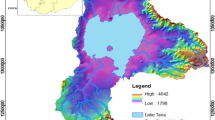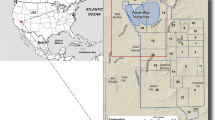Abstract
Hydrochemical, multivariate statistical and inverse hydrogeochemical modeling techniques were used to investigate groundwater recharge, flow and the hydrochemical evolution within the Akaki volcanic aquifer system, central Ethiopia. The hydrochemical and multivariate statistical techniques are mutually supportive and the extracted information was analyzed together with environmental isotope data. Results reveal five spatial groundwater zones with defined hydrochemical facies, residence times, stable isotopic signals and hydrochemical evolution. These zones are designated as the (1) Intoto, (2) central, (3) Filwuha fault, (4) south zones and (5) a highly polluted sub-sector identified within the central zone. Both the hydrochemical and multivariate statistical analyses have shown the central sub-sector as being spite of differentially polluted by \({\text{NO}}^{ - }_{3}\), Cl− and \({\text{SO}}^{{2 - }}_{4}\) and its tritium content shows recent recharge. Due to the fact that the main recharge source is precipitation, the hydrochemical and environmental isotope data clearly indicated that the central and southern sectors are also recharged from domestic waste water and leakage from water mains and reservoirs. Inverse hydrogeochemical modeling demonstrated reactions of silicate minerals in a CO2 open system and precipitation of kaolinite, chalcedony, and rare calcite satisfy the observed change in water chemistry from north to south following the regional flow direction.
Résumé
Des techniques relevant de l’hydrochimie, des statistiques multivariées et de la modélisation inverse hydrogéochimique, ont été utilisées dans le cadre de l’étude de la recharge des eaux souterraines, de l’écoulement et de l’évolution hydrochimique dans le système volcanique aquifère d’Akaki au centre de l’Ethiopie. Les techniques hydrochimiques et multivariées se supportent mutuellement et l’information extraite a été analysée avec les données isotopiques environnementales, des temps de résidence, des signaux isotopiques stables et une évolution hydrochimique. Ces zones ont été désignées comme le (1) Intoto, (2) le centre, (3) la faille de Filwuha, (4) les zones sud et (5) un sous-secteur fortement pollué identifié dans la zone centrale. Les analyses statistiques hydrochimiques et multivariées ont montré que le sous-secteur central a été différemment pollué par \({\text{NO}}^{ - }_{3}\), Cl− et \({\text{SO}}^{{2 - }}_{4}\), tandis que la teneur en tritium montre une recharge récente. Malgré le fait que la principale source de recharge soit les précipitations, les données hydrochimiques et isotopiques indiquent clairement que les secteurs centres et sud sont également rechargés par les eaux usées domestiques et les fuites de réservoirs et canalisations d’eau. La modélisation hydrogéochimique inverse a démontré les réactions des minéraux silicatés dans un système ouvert au CO2, et la précipitation de kaolinite, de calcédoine, et la rareté de la calcite satisfont les changements observés dans la chimie de l’eau du nord vers le sud en suivant la direction régionale de l’écoulement.
Resumen
Se utilizaron la hidroquímica y técnicas de modelación hidrogeoquímica inversa y estadística multivariada, para investigar la recarga del agua subterránea, el flujo y la evolución hidroquímica, dentro del sistema acuífero volcánico Akaki, Etiopía Central. La hidroquímica y las técnicas estadísticas multivariadas se complementan entre si y la información así extraída se analizó junto con los datos de isótopos ambientales. Los resultados revelan cinco zonas diferentes de agua subterránea, con facies hidroquímicas, tiempos de residencia, improntas isotópicas estables y una evolución hidroquímica definidas. Estas zonas se designan como (1) Intoto, (2) Central, (3) Falla de Filwuha, (4) las Zonas del sur y (5) un sub-sector altamente contaminado identificado dentro de la zona central. Tanto los análisis estadísticos multivariados como la hidroquímica, han mostrado al sub-sector central como contaminado diferencialmente por \({\text{NO}}^{ - }_{3}\), Cl− y \({\text{SO}}^{{2 - }}_{4}\) y su contenido de tritio muestra una recarga reciente. A pesar del hecho que la fuente principal de recarga es la precipitación, los datos de hidroquímica y de isótopos ambientales indican que los sectores central y del sur, también se recargan a partir de agua doméstica usada y del goteo de las conducciones del acueducto y de sus reservorios. El modelamiento hidrogeoquímico inverso demostró reacciones de minerales silicatados en un sistema de CO2 abierto, y la precipitación de caolinita, calcedonia, y rara vez de calcita, satisfacen el cambio observado en la química de agua del norte a sur, siguiendo la dirección del flujo regional.









Similar content being viewed by others
References
AAWSA, BCEOM, SEURECA, Tropics (2000) Addis Ababa Water Supply Project Stage-IIIA Groundwater-Phase II, Modeling of Akaki well field, V1, main report. Addis Ababa Water and Sewerage Authority, Addis Ababa, Ethiopia, p 54
Abebe T, Francesco M, Fabrizio I, Piero M (1999) Geological map of Debre Zeyt area (Ethiopia). Acta Vulcanol 11(1), Giardini Editore, Pisa, Italy
Adams S, Titus R, Pietersen K, Tredoux G, Harris C (2001) Hydrochemical characteristics of aquifers near Sutherland in the Western Karoo, South Africa. J Hydrol 241:91–103
Alemayehu T (2001) The impact of uncontrolled waste disposal on surface water quality in Addis Ababa, Ethiopia. SINET Ethiop J Sci 24(1):93–104
Ashley RP, Lloyd JW (1978) An example of the use of factor analysis and cluster analysis in groundwater chemistry interpretation. J Hydrol 39:355–364
Brown CE (1998) Applied multivariate statistics in geohydrology and related sciences. Springer, Berlin, pp 248
Clark ID, Fritz P (1997) Environmental isotopes in hydrogeology. Lewis, New York, p 328
Craig H (1961) Standards for reporting concentration of deuterium and oxygen-18 in natural waters. Science 133:1833–1834
Davis SN, DeWiest RJM (1966) Hydrogeology. Wiley, New York, pp 463
Demirel Z, Güler C (2006) Hydrogeochemical evolution of groundwater in a Mediterranean coastal aquifer, Mersin-Erdemli basin (Turkey). Environ Geol 49:477–487
Deutsch WJ (1997) Groundwater geochemistry: fundamentals and applications to contamination. Lewis, New York, 221 pp
Edmunds WM, Smedley P (2000) Residence time indicators in groundwater: the East Midlands Triassic sandstone aquifer. Appl Geochem 15:737–752
Gaspron M, Innocentti F, Magetti P, Piccerillo A, Tsegaye A (1993) Genesis of the Pliocene to Recent bimodal mafic-felsic volcanism in the Debre Zeyt area, central Ethiopia: volcanological and geochemical constraints. J Afri Earth Sci 17(2):145–1993
Girma A (1994) Hydrogeology of Akaki area. MSc Thesis, Addis Ababa University, Addis Ababa, Ethiopia, p 136
Girmay H, Assefa G (1989) The Addis Ababa-Nazreth volcanics: a Miocene–Pleistocene volcanic succession in the Ethiopian Rift. SINET Ethiop J Sci 12(1):1–24
Gizaw B (2002) Hydrochemical and environmental investigation of the Addis Ababa Region, Ethiopia. PhD Thesis, Ludwig Maximilians University of Munich, Germany, p 157
Güler C, Thyne DG, McCray EJ, Turner AK (2002) Evaluation of graphical and multivariate statistical methods for classification of water chemistry data. Hydrogeol J 10:455–474
Hussein MT (2004) Hydrochemical evaluation of groundwater in the Blue Nile Basin, eastern Sudan, using conventional and multivariate techniques. Hydrogeol J 12:144–158
IAEA/WMO (2004) Global network of isotopes in precipitation. International Atomic Energy Agency/World Meteorological Agency, GNIP database (http://Isohis.iaea.org). Cited 15 May 2004
Kebede S, Travi Y, Alemayehu T, Ayenew T (2005) Groundwater recharge, circulation and geochemical evolution in the source region of the Blue Nile River, Ethiopia. Appl Geochem 20(9):1658–1676
Kenoyer GJ, Bowser CJ (1992) Groundwater chemical evolution in a sandy aquifer in northern Wisconsin. 2. Reaction modeling. Water Resour Res 28:591–600
McKenzie J, Siegel D, Patterson W, McKenzie J (2001) A geochemical survey of spring water from the main Ethiopian Rift Valley, southern Ethiopia: implications for well head protection. Hydrogeol J 9:265–272, DOI 10.1007/s100400100134
Mohr P, Zanettin B (1988) The Ethiopian flood basalt province. In: Macdougall JD (eds) Continental flood basalts. Kluwer, Dordrecht, pp 63–110
Morton WH (1974) Geological map of Addis Ababa. Addis Ababa University, Ethiopia
Parkhurst DL, Appelo CAJ (1999) User’s guide to PHREEQC: a computer program for speciation, batch-reaction, one-dimensional transport, and inverse geochemical calculations. US Geol Surv Water-Resour Invest Rep 99–4259
Plummer LN, Back M (1980) The mass balance approach: application to interpreting the chemical evolution of hydrological systems. Am J Sci 280:130–142
Plummer LN, Parkhurst DL, Thorstenson DC (1983) Development of reaction models for groundwater systems. Geochim Cosmochim Acta 47:665–686
Simie I (1999) Addis Ababa water supply stage III-A project. Ethiopian Engineering Society, Addis Ababa, Ethiopia, March 1998, p 13
SPSS Inc. (1999) SPSS for Windows, Rel. 10.0.1. SPSS Inc., Chicago
Swanson SK, Bahr JM, Schwar MT, Potter KW (2001) Two-way cluster analysis of geochemical data to constrain spring source waters. Chem Geol 179:73–91
Tsehayu K, Hailemariam T (1990) Engineering geological map of Addis Ababa, Ethiopian Institute of Geological Surveys. Addis Ababa, Ethiopia
Vernier A (1993) Aspects of Ethiopian hydrogeology: from geology and mineral resources of Somalia and its surrounding regions. Ist Agron Oltremare Firenze Relaz Monogr 113:687–698
Zanettin B, Justin-Visentin E (1974) The volcanic succession in central Ethiopia: the volcanics of the western Afar and the Ethiopian Rift Margins. Mem Ist Geol Miner Univ Padova V 31:1–19
Acknowledgments
The authors are grateful to the German Academic Exchange Service (DAAD) for the partial financial support of the field research work and a PhD grant to the first author. Thanks to Dr. W. Stichler (Laboratory of GSF, Forschungszentrum fuer Umwelt und Gesundheit, Institute for Groundwater Ecology, Munich) for the analysis of δ18O, δD and 3H. Thanks to Mr. N. Richard and Mr. D. Barnke (Department of Applied Geology, Ruhr University of Bochum) for the assistance received in analyzing the hydrochemical samples in the laboratory and Dr. T. Fockenberg (Institute of Geology, Mineralogy and Geophysics, Ruhr University of Bochum) for XRF analysis of the rock samples. We thank the anonymous reviewers for constructive comments which have improved the quality of the manuscript.
Author information
Authors and Affiliations
Corresponding author
Electronic supplementary material
Below is the link to the electronic supplementary material.
ESM 1
Hydrochemical and stable isotope data of groundwater in the Akaki catchment (DOC 697 kb)
Rights and permissions
About this article
Cite this article
Demlie, M., Wohnlich, S., Wisotzky, F. et al. Groundwater recharge, flow and hydrogeochemical evolution in a complex volcanic aquifer system, central Ethiopia. Hydrogeol J 15, 1169–1181 (2007). https://doi.org/10.1007/s10040-007-0163-3
Received:
Accepted:
Published:
Issue Date:
DOI: https://doi.org/10.1007/s10040-007-0163-3




